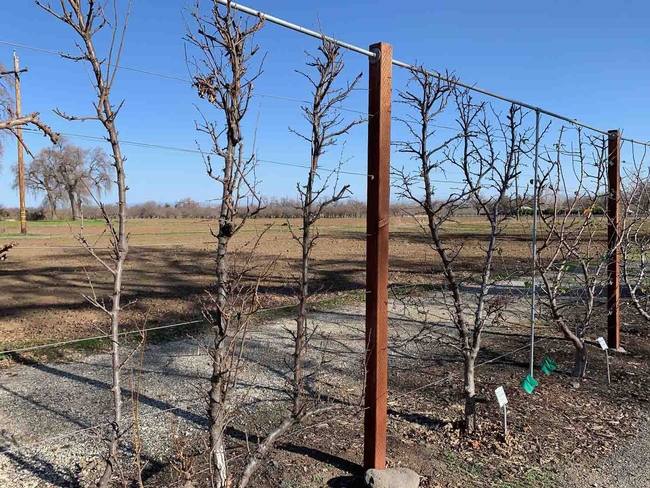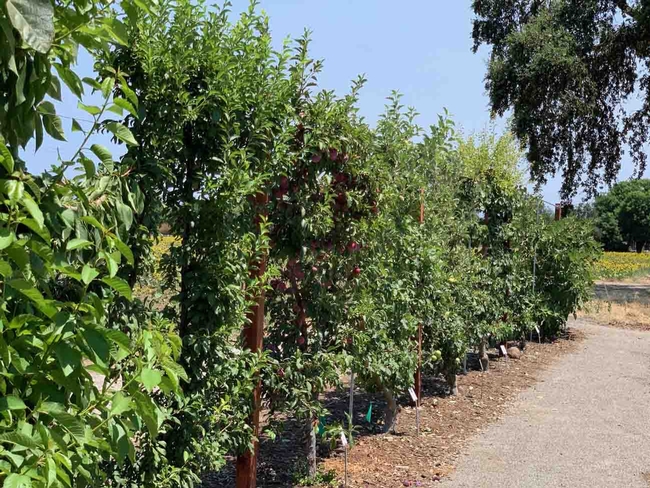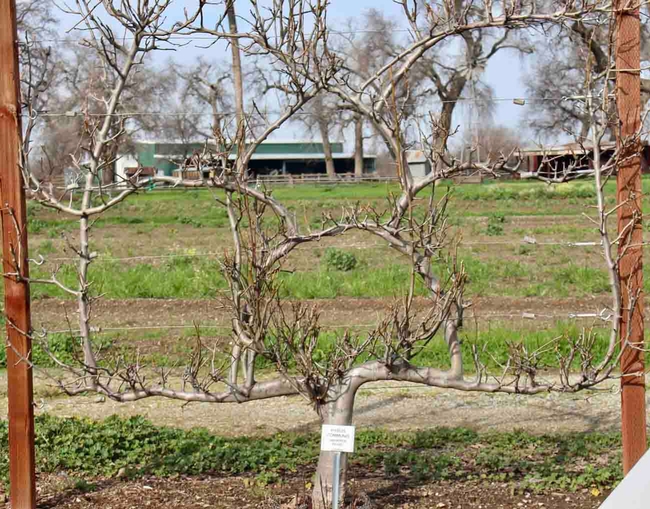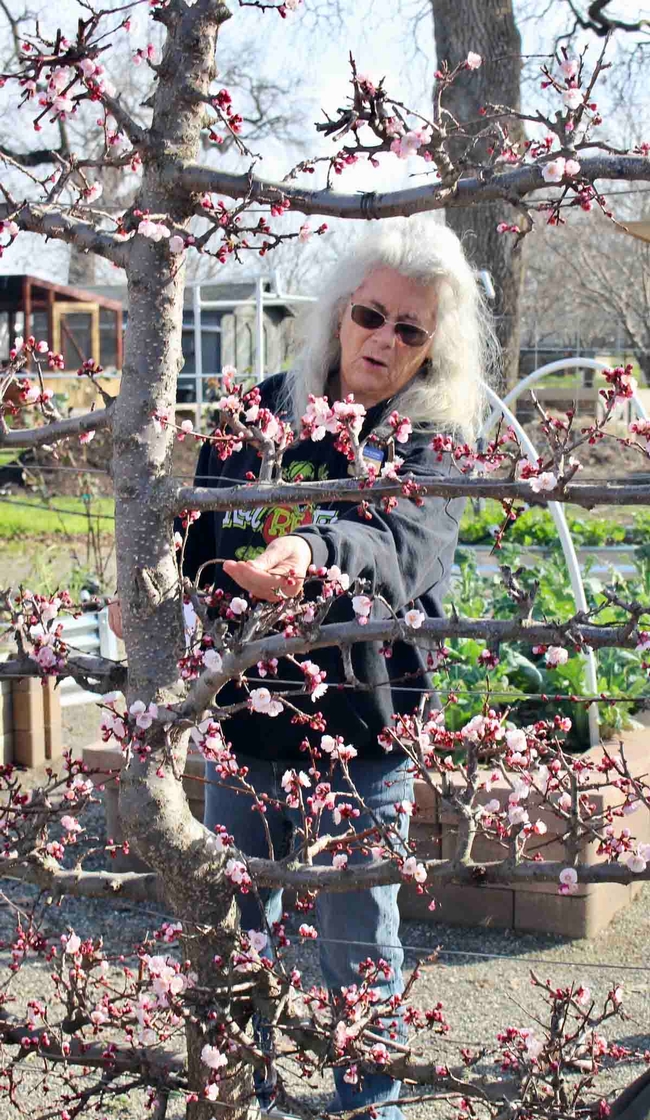There is a bit of ancient Rome and a taste of old Egypt at the Master Gardener Demonstration Garden at the Patrick Ranch. Butte County MGs are practicing espaliering, the early horticultural art of training and pruning a tree or shrub to grow flat against a support. Espaliering is believed to have been practiced by the early Romans, and hieroglyphs of espaliered fig trees have been found in Egyptian tombs from as long ago as 1400 BCE. In the Middle Ages, Europeans refined espaliering into an art, and designs became increasingly decorative and elaborate.

The word “espalier” is French, but it comes from the Italian spalliera, meaning “something to rest the shoulder (spalla) against.” Eventually, it came to mean both the practice of training and shaping plants to a frame, and the plants themselves.
An Espalier Garden Grows in Chico
In late spring 2015, a small group of Butte County Master Gardeners proposed an Espalier Garden for the educational gardens being developed by the Master Gardeners at Patrick Ranch. They created plans to showcase fruit trees and to display different patterns of espaliering. From there, they embarked on the basic steps of espaliering: site selection, espalier structure design, tree variety selection, planting technique, espalier pattern choices, and methods of pruning and training. The trees were planted in Spring 2016.

Espalier Structure Design: Because the Espalier Garden is a teaching tool, the Master Gardeners built sturdy, long lasting espalier supports. The structure consists of pressure-treated 4 x 4 posts with eyehooks supporting wire cable that can periodically be tightened. The cable is strung horizontally at one-foot intervals, although intervals of up to two feet are also common. The home gardener could use a length of hog/cattle wire instead of cable.
Tree / Vine Variety Selection: Certain types of trees adapt better to this practice than others, but almost any woody plant can be trained to grow along a flat plane. Grapevines are particularly adaptable to espaliering. Fig and apple trees are also good choices.
Fruit tree varieties should be self-pollinating, unless several trees of the same variety are planted in proximity. Select bare root trees that are not fully branched or budded out, as once planted, they are cut back to a single cane (if they are already branching, prune to leave branch stubs with two buds to make sure you get re-growth at each node). The Master Gardeners have planted Tiger Fig, Lapins Cherry, Santa Rosa Plum, Pluot, Fuji Apple, Arkansas Black Spur Apple, Plumcot/Aprium, Brown Turkey Fig, Warren Plum, and North Star Cherry in their Espalier Garden.

Espalier Pattern Choices: There are many designs to choose from, ranging from traditional formal patterns developed over hundreds of years, to modern informal designs. Among the most common are V-Shaped; Candelabra; Belgian Fence; Cordon (horizontal or double vertical); and Palmette or Fan. The MGs chose for their Espalier Garden two types of candelabras, a fan, a horizontal cordon, a Belgian Fence, and the elegant Crossover pattern.
Pruning and Training to Espalier: Expect to engage in heavy pruning and training for the first one to three years. After five to seven years, the tree will retain its shape even if the support structure deteriorates or is removed. Any major pruning is generally accomplished either while the plant is dormant, or during the proper season for pruning that species. Bending and tying limbs that remain in the design is done during the summer season as growth progresses, when shoots are most flexible. The Master Gardeners use rubber anchor bands to tie the limbs and shoots to their supports. Whatever you use, ties should be loose enough that water and nutrients can move through the phloem.

The ten fruit trees selected and planted by the Master Gardeners are in their eighth year of espalier training. You can view the developing espaliers at the Master Gardener Demonstration Garden at Patrick Ranch, Saturdays and Sundays from 11 am to 3 pm.
For more information on espalier training, a good reference work is Pruning and Training published by the American Horticultural Society.
Attend our Espalier workshop on November 8. For descriptions of this and all the other workshops in the Master Gardeners' Fall Workshop Series, visit our website. All workshops are free, but registration is required; registration for all November workshops opens on October 1st.
Come to our Plant Sale on Saturday, September 30, 9 am till noon at our Demonstration Garden at Patrick Ranch, 10381 Midway, Durham. For more information including a list of the plants that will be available visit our Plant Sale webpage. Two free workshops (no registration required) will be offered during the plant sale: No-Fail Native Plants at 10 am, and Raised Garden/Vegetable Beds at 10:30.
UC Master Gardeners of Butte County are part of the University of California Cooperative Extension (UCCE) system. To learn more about us and our upcoming events, and for help with gardening in our area visit our website. If you have a gardening question or problem, email the Hotline at mgbutte@ucanr.edu or leave a phone message on our Hotline at 530-552-5812. To speak to a Master Gardener about a gardening issue, or to drop by the MG office during Hotline hours, see the most current information on our Ask Us section of our website.